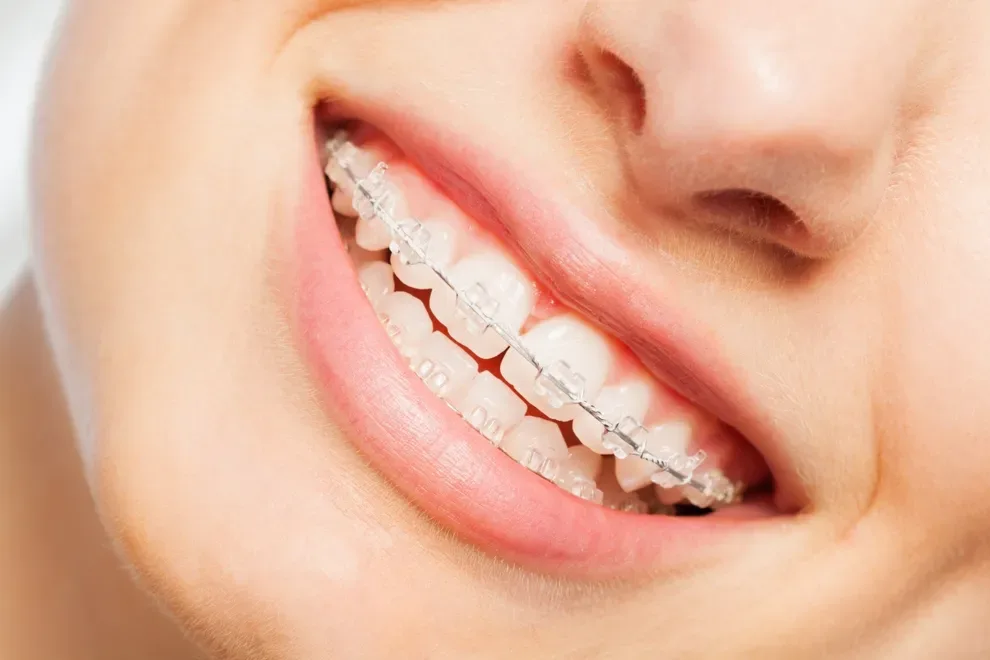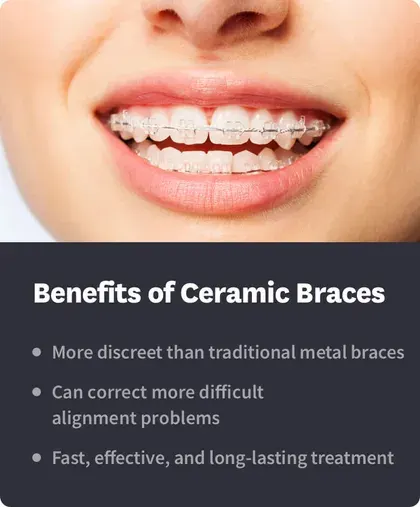Ceramic Braces: Pros, Cons & Cost

Table of Contents
- Benefits
- Downsides
- Effectiveness
- Cost Comparison
- Durability
- Treatment Duration
- Candidate
Ceramic braces are a more discrete choice for people who have severe misalignment or bite issues that require braces. They are more expensive than metal braces, and they can get stained.
Since more adults are seeking orthodontic treatment to adjust misalignments, the dental industry has developed several options for orthodontic devices that are less noticeable but still effective. For example, clear aligners have gained immense popularity since they can be worn for several hours a day and are barely visible. However, clear aligners may not be an effective option for everyone.
Ceramic braces are white or slightly off-white braces that work like traditional metal braces. They are bonded to your teeth and use metal wires, which are tightened slightly over time, to realign your teeth.
Ceramic braces are more aesthetically pleasing for many people. They can be more effective for moderate or severe alignment issues compared to clear aligners.

The Benefits of Ceramic Braces
Ceramic brackets were introduced in the 1980s as an alternative to traditional metal braces.
They are still one of the best options for improving the alignment of your teeth without being very noticeable. Although ceramic braces still require metal wires, it is possible to use white plastic coatings on the wires to improve the overall appearance of the braces and make them even less noticeable.
Ceramic braces are an excellent option for people who have alignment problems that are more difficult for clear plastic aligners to manage, especially if they want faster dental treatment. These brackets are tougher than plastic aligners, so they put greater pressure on teeth, similar to what metal braces do.
They are clear, white, or the color of your teeth, so they aren’t as visible as metal braces. If you have moderate or severe misalignment or malocclusion of your teeth, ceramic braces can be a good option for fast, effective, and long-lasting treatment.
Modern ceramic braces are much more advanced than their older counterparts. For example, they’re made of stronger materials that are more likely to resist staining. If you have ceramic braces, you should be careful to avoid staining products. However, newer ones may be much more resistant to these problems.
Modern ceramic braces can also come with self-ligating features, meaning that you don’t need colorful rubber bands to hold them in place. These devices could be even harder to see than older ceramic braces once were.

The Downsides of Ceramic Braces
Although ceramic braces are a good option for many people, they have some downsides compared to traditional metal braces or plastic aligners.
Clear, plastic aligners are nearly invisible, while ceramic braces still require metal wires to straighten teeth, which can be seen. If you are more concerned with visibility than the speed of treatment, you may opt for clear aligners rather than ceramic braces.
Ceramic braces can become discolored. While proper oral hygiene is an important part of any orthodontic treatment, many people find that ceramic braces get discolored easily.
Coffee, tea, soy sauce, and foods or drinks with high acid content can all cause enamel and ceramic discoloration. With ceramic braces, it will be hard to lighten or remove stains.
If you are concerned about cost, ceramic braces are more expensive than traditional metal braces. While these two options are similar in their level of effectiveness and speed of treatment, ceramic requires production processes that metal does not, which increases the cost.
Ceramic braces may be about the same price as Invisalign, but they are more costly compared to other types of clear plastic aligners, like over-the-counter, at-home options.
Ceramic is also more brittle than metal, so this type of orthodontic device can be harder to apply well to your teeth. It is important for ceramic not to come in direct contact with the enamel of your teeth, as this can cause cracking or wear.
Ceramic braces are harder to remove than metal braces, which increases the cost of this approach to treatment. Although modern ceramics are very durable, they might still partially fracture or fail, especially during tightening or removal. This may damage your teeth, but it can also make your treatment plan take longer.
Cracks, fractures, and enamel flaking have all been reported by dentists during the process of removing ceramic brackets. They often use special tools to remove ceramic that they would not need to use to remove metal brackets.
Cost comparison of ceramic braces to other orthodontia
The typical cost of ceramic braces can vary depending on your dental insurance, where you live, and how long you need treatment. The current estimated cost ranges from $4,000 to $8,000. This is roughly the same cost as dentist-prescribed clear aligners, provided through Invisalign.
Ceramic braces are also less expensive than lingual braces, which are metal brackets placed on the backside of your teeth rather than outside. However, ceramic braces are more expensive than metal braces.
Here is the cost comparison:
Ceramic braces: $4,000–$8,000 for full treatment
Lingual braces: $8,000–$10,000 for full treatment
Invisalign: $4,000–$7,400 for full treatment
Traditional metal braces: $3,000–$7,000 for full treatment
Over-the-counter, clear aligners: $2,000–$4,000 for full treatment
Know that these fees are only estimates and shouldn’t be considered hard-and-fast costs. Your price can vary due to factors like your location, the dental professional you choose, and the complexity of your case.
Other costs associated with ceramic braces include the following:
Initial visits: $100 to $200
Dental x-rays: $10 to $250
Retainers: $200 to $1,000
Research from CostHelper suggests that most orthodontists don’t charge extra for in-office appointments and adjustments. Those fees are included in the standard price of care. However, if you break one of your brackets, your dental professional could charge you to fix it. Those fees are typically around $100 per bracket.
Some types of aligners (including Invisalign) may also come with fees associated with initial visits, X-rays, and retainers. However, doctor-directed, at-home versions like Byte don’t have these fees. However, if you break or lose an aligner tray, you may be charged to replace it.
While price may be a major part of your decision when looking at orthodontic treatment, it is important to ask your dentist for their help too. Many people can correct mild to moderate malocclusions with clear plastic aligners, for example.
Over-the-counter aligners are a good option to take control of your orthodontic treatment, but they do not solve every dental misalignment or health problem.
| Cost | Visibility | Conditions treated | Pros | Cons | |
|---|---|---|---|---|---|
| metal braces | $3,000 - $7,000 | most visible, with metallic hardware | treatment plans for major or complex smile issues | most affordable; can treat a wide range of issues | wearers may feel self-conscious; braces aren’t removable and require in-office adjustments |
| ceramic braces | $4,000 - $8,000 | less visible than metal braces; white or tooth-colored hardware | treats most orthodontic issues | more discreet than braces and can treat a wider range of issues than aligners | may be prone to discoloration and staining; aren’t removable and require in-office adjustments; more expensive than metal braces; easier to damage than metal braces |
| lingual braces | $8,000 - $10,000 | nearly invisible, as hardware is attached to back of teeth | treats most orthodontic issues | virtually invisible; can treat a wider range of issues than aligners can | expensive; may be more uncomfortable and cause problems when eating and talking; harder to clean |
| in-office aligners (including invisalign) | $4,000 - $7,400 | virtually invisible | treats mild to moderate issues as well as some more complicated problems; may be used with traditional braces for more major issues | removable and clear; a discreet alternative to traditional braces; usually faster than braces | costly treatment, especially when compared to at-home aligners or metal braces; less convenient than at-home aligners |
| at-home aligners | $2,000 - $4,000 | virtually invisible | treats mild to moderate issues like crowding, gaps, and rotation | fast results; straightforward and affordable pricing and financing; potential for completely remote treatment for convenience | must be worn as prescribed to work; limited or no in-office care; may not be able to treat more complex smile issues |
Ceramic Braces Work for Many People
If you want fast but discreet orthodontic treatment, ceramic braces could be right for you. They are similar in effectiveness and speed to metal braces since they are worn constantly until your dentist removes them. But they are less visible compared to bulky metal braces.
You will need to avoid certain foods like caramel, gum, or popcorn while you have ceramic braces. You may need to use special types of floss to get between the wires to prevent food building up there.
If you have moderate or severe misalignment or malocclusion, ceramic braces work faster and give you longer-lasting results than plastic aligners. However, they are less cost effective than metal braces or most clear aligners.
How durable are ceramic braces?
Ceramic brackets are incredibly strong. In fact, researchers say that ceramic brackets are nine times harder than their stainless steel counterparts. That means ceramic braces are much less likely to fall apart. However, that doesn’t mean they are break-proof.
For braces to work, they must stay attached to your teeth. This fact can make ceramic versions fail. Ceramic doesn’t always bond quickly to the enamel on your teeth. That means they could come detached and slide around on the wire until your doctor fixes the issue.
While ceramic braces can break, they’re less likely to fail than their metal counterparts. For example, in 2020, researchers followed 20 patients who had braces. One group used metal brackets and the other used ceramic. After 12 months, 16 metal brackets failed, and 2 ceramic versions broke. That means metal was much more likely to break than ceramic.
Does treatment with ceramic braces take longer?
The complexity of your case has a deep impact on how long treatment takes. The farther your teeth have to move, the longer you might need to wear braces. In general, the type of bracket you use doesn’t impact how long you’re in treatment.
For example, in a study of 134 patients using many different types of brackets, researchers found that treatment lasted an average of 28.63 months. The researchers couldn’t find a difference in treatment duration between them. Instead, they found that the length of treatment had more to do with the dental issues, cooperation of the patient, and the number of teeth removed before treatment started.
Who can get ceramic braces?
The American Dental Association says that treatment with braces often begins when people are 8 to 14. At this age, a child’s baby teeth have been replaced by their adult versions, so they’re ready to be moved to ideal positions.
Anyone could benefit from ceramic braces, including people in the lower age bracket. However, braces must be treated carefully to prevent them from breaking. People must also brush their teeth carefully to ensure their dental health doesn’t decline during treatment.
